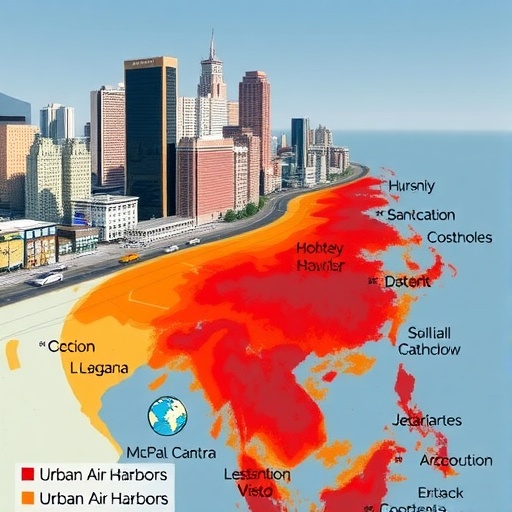In a groundbreaking study published in the upcoming issue of Environmental Science & Technology Letters, researchers have unveiled compelling evidence that pathogenic strains of Candida yeasts exist in urban air but are conspicuously absent in coastal environments. This finding challenges long-standing paradigms about the transmission of Candida, a genus of yeasts traditionally associated with infections spread by direct contact or bodily fluids. The team led by Ling Nathanael Jin conducted a meticulous, year-long pilot study in Hong Kong, revealing that urban air harbors airborne Candida with significant public health implications.
Yeasts of the genus Candida are ubiquitous microorganisms that normally colonize the skin and mucosal membranes of healthy individuals without causing harm. Under specific circumstances, however, certain Candida species can proliferate excessively, leading to clinical conditions such as vaginal candidiasis or oral thrush. These infections have long been understood to spread predominantly via direct person-to-person contact or exposure to infected bodily fluids. Yet, prior molecular studies detecting Candida DNA fragments in the air hinted at the possibility of airborne transmission, sparking curiosity about the viability and infectivity of such airborne yeasts.
Jin and colleagues sought to clarify this uncertainty by systematically collecting viable air samples from two distinct locations: a densely populated urban area in Hong Kong and a comparatively pristine coastal site overlooking the South China Sea. Sampling occurred monthly over a full calendar year to account for seasonal variability in yeast presence. Intriguingly, live Candida cells were recovered solely from the urban air samples. The isolates included three species—Candida albicans, Candida parapsilosis, and Candida tropicalis—all designated by the World Health Organization as fungal pathogens of critical concern due to their role in opportunistic infections and increasing drug resistance worldwide.
The stark absence of Candida in samples drawn from the coastal site suggests a profound environmental influence on airborne fungal communities. The researchers hypothesized that urban industrial activities, such as wastewater treatment processes, could serve as prolific sources of aerosolized Candida. Industrial operations may facilitate the release of fungal propagules into the atmosphere, where they persist long enough to pose inhalation risks for urban inhabitants. This association underscores the intricate interplay between anthropogenic factors and microbial ecology in metropolitan atmospheres.
Adding urgency to the findings, some Candida strains isolated from urban air demonstrated remarkable resistance to commonly used antifungal medications. The genesis of this resistance remains complex and multifactorial, but the study postulates that excessive antifungal use in clinical and agricultural settings, along with environmental stressors such as heavy metal pollution and elevated temperatures induced by urban heat islands, may select for resistant phenotypes. This emerging resistance challenges existing treatment paradigms and heightens the threat of airborne fungal infections that are difficult to manage therapeutically.
Genomic analysis further revealed that the airborne Candida strains share close genetic affiliations with clinical isolates recovered from infected patients. This genetic similarity bolsters suspicions that airborne Candida is more than a passive environmental contaminant; rather, it may represent an active vector facilitating community-acquired infections. If substantiated by further research, this transmission route could redefine infection control measures and public health policies related to fungal diseases.
The revelation that Candida may be transmitted not only via contact but also through air calls for a paradigm shift in our understanding of fungal epidemiology. Airborne transmission would imply that routine environmental monitoring and air quality assessments should incorporate fungal viability and pathogenic potential as critical parameters. Such practices are currently scant, and their incorporation could enhance early detection of outbreak-prone airborne pathogens before they impact vulnerable populations.
While these findings are provocative, the study authors caution that this pilot research is preliminary. Comprehensive investigations are required to elucidate the precise origins of urban airborne Candida, to quantify the human exposure levels, and to unravel the dynamics of infection following inhalation. Furthermore, understanding the environmental factors that modulate the viability and virulence of airborne yeasts is essential to devising effective mitigation strategies.
The implications of airborne Candida extend beyond clinical microbiology, touching on urban planning, environmental health, and even climate science. Urban landscapes, with their unique microclimates and pollutant profiles, could unknowingly foster airborne reservoirs of fungal pathogens, demanding multidisciplinary approaches to tackle this emergent health concern. Collaborative efforts integrating environmental engineers, public health officials, and mycologists will be paramount in addressing this multifaceted challenge.
Funding for this pioneering research was provided by several institutions, including the Research Grants Council of Hong Kong, the National Natural Science Foundation of China, and the Research Institute for Sustainable Urban Development Joint Research Fund, among others. These bodies recognize the urgency and novelty of investigating airborne fungal pathogens within the broader narrative of urban environmental health.
As the scientific community digests these findings, the public may find solace in the continued emphasis on environmental hygiene and personal protection, especially in densely populated urban centers. Vigilance in antifungal stewardship and environmental pollution control may curtail the proliferation of resistant airborne pathogens, safeguarding public health in an increasingly urbanized world.
This study adds to the growing body of evidence that microbial pathogens can exploit diverse transmission pathways, some previously underestimated or overlooked. Airborne Candida represents a potential emerging threat that underscores the adaptability and resilience of microbial life, demanding sustained attention from researchers and public health authorities alike.
Subject of Research: Airborne transmission of Candida yeasts and their public health implications in urban versus coastal environments
Article Title: Public Health Implications of Airborne Candida: Viability, Drug Resistance, and Genetic Links to Clinical Strains
News Publication Date: 1-Oct-2025
References: Environmental Science & Technology Letters 2025, DOI: 10.1021/acs.estlett.5c00795
Image Credits: Yolanda Wang, adapted from Environmental Science & Technology Letters 2025, DOI: 10.1021/acs.estlett.5c00795
Keywords
Chemistry, Yeasts
Tags: airborne transmission of fungiCandida species and infectionsenvironmental microbiology researchenvironmental science and technologyHong Kong air quality studymicrobial contamination in urban areaspathogenic Candida yeastspathogenic microorganisms in urban settingspublic health implications of yeast infectionsurban air qualityurban vs coastal microbial environmentsyeast infection epidemiology





